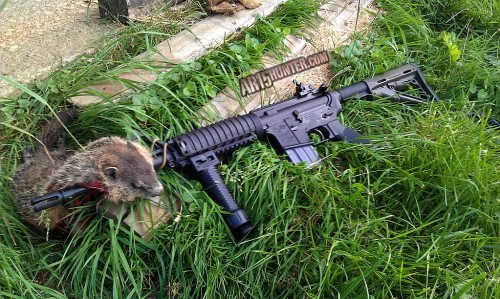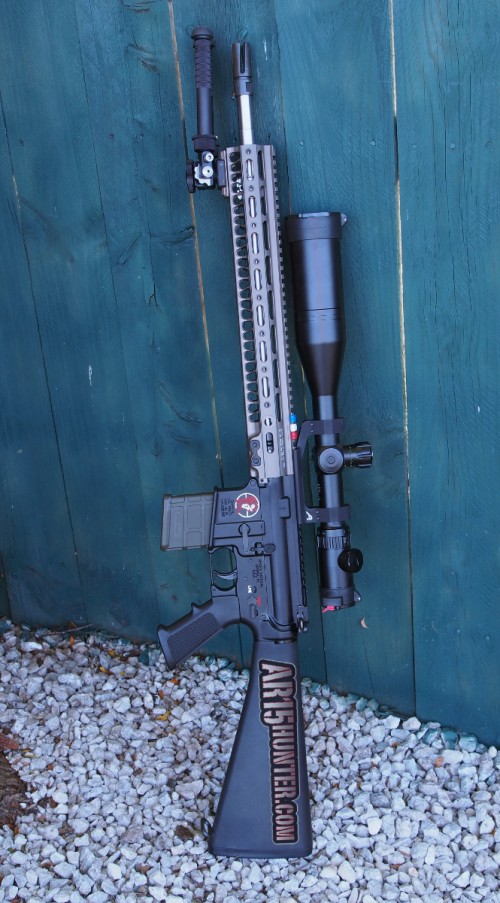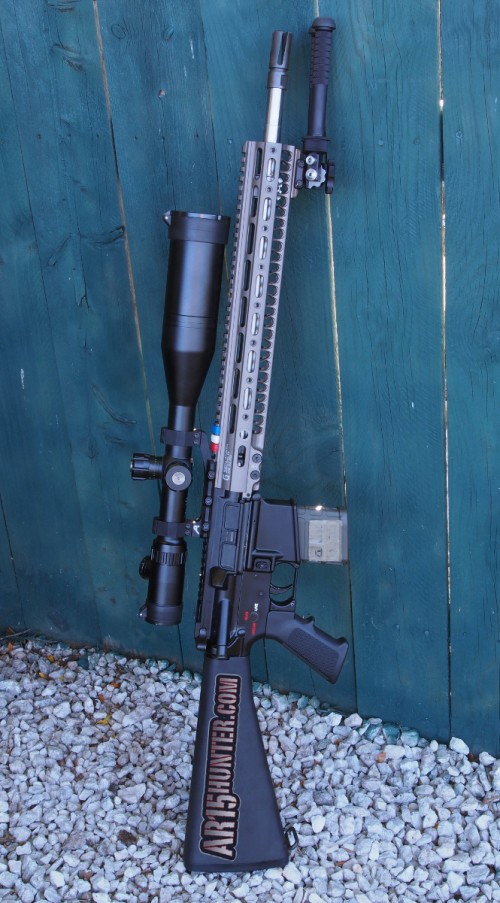 When you tell some people that you are hunting ground hogs with an AR15, they’ll ask; “Why do you have to kill ground hogs, do they really do any damage?”. The answer is YES, they do lots of damage. From helping along bank erosion, to putting dangerous holes all over a farmer’s fields, ground hogs are a nuisance; one that most any farmer is glad to see gone. I happen to have family who raises cattle in SE Ohio, and they make a great deal of hay in the summer. They despise grounds hogs, since their holes can hurt cattle if they accidentally step in one, and these same holes can be seriously hard on equipment in the hay field; not to mention dangerous for those riding on the wagon staking hay bales.
When you tell some people that you are hunting ground hogs with an AR15, they’ll ask; “Why do you have to kill ground hogs, do they really do any damage?”. The answer is YES, they do lots of damage. From helping along bank erosion, to putting dangerous holes all over a farmer’s fields, ground hogs are a nuisance; one that most any farmer is glad to see gone. I happen to have family who raises cattle in SE Ohio, and they make a great deal of hay in the summer. They despise grounds hogs, since their holes can hurt cattle if they accidentally step in one, and these same holes can be seriously hard on equipment in the hay field; not to mention dangerous for those riding on the wagon staking hay bales.
So, during the summers, I try my best to take out as many whistle pigs as I can. My rifle of choice is an AR15, and my current hunting rig consists 18″ SPR-type upper using an ADCO branded White Oak Armament barrel with a .223 Wylde chamber (can shoot both .223 and 5.56mm). I currently use some of my hand loaded 55gr Hornady V-max projectiles in .223 spec. I’ve found a very conservative load of ~22.2 grains of TAC under the 55gr V-max that flies at an average of 2706FPS out of my 18″ barrel. This is slower than most factory V-max loads, but I’ve found it to be quite accurate for me out past 200 yards, and there’s still plenty of energy to take down ground hogs and other prey. With my rifle sighted in at 50 yards, I have a deadly combo for smacking ground hogs from as close as 25 yards on out.
Another nice thing about hunting ground hogs during the summer is that it’s good practice. Shooting at small critters can be a challenge, and doing so helps to improve your marksmanship; a fundamental component to being a successful hunter. If you can find the time, and a safe place to hunt ground hogs, I highly recommend it. Not only will the farmer thank you, but the experience and practice will help you to be more successful on larger game, whether you’re hunting predators or white tail deer. Knowing how your rifle shoots and where it impacts at various ranges is extremely important for a hunter, and shooting at small targets like ground hogs is about the best practice I can think of. Sure, you can set up some paper or steel at your local range, however most have a set distance and many require you to have your target directly at the backstop. While it’s still a good idea to practice at the range, getting out in the field and shooting is where you will really learn your rifle. Instead of taking 25, 50, or 100 yards shots at your local range, you could be taking 37, 66, or 123 yard shots out in the field.
 While I now use a scope to hunt ground hogs, I started out using good ole GI iron sights. Sure, you can’t really shoot at some of the longer distances, but I was still successful around some local farms with just my AR, iron sights, and some good ammo. So, don’t let not having a scope be an excuse not to get out there and hunt! In either case, always be aware of your surroundings and shoot safely.
While I now use a scope to hunt ground hogs, I started out using good ole GI iron sights. Sure, you can’t really shoot at some of the longer distances, but I was still successful around some local farms with just my AR, iron sights, and some good ammo. So, don’t let not having a scope be an excuse not to get out there and hunt! In either case, always be aware of your surroundings and shoot safely.
If you’re already hunting with your AR, we’d love to hear from you. Be sure to share your experiences, tips, etc. on either our Facebook page or forums. You never know, your story may end up on the front page of AR15Hunter.com!
Gear specs:
- Upper: Bravo Company A3 upper with M4 cuts
- Barrel: ADCO (White Oak) 18″ SPR barrel with 1/7 twist and .223 Wylde chamber and Geissele Super Gas Block
- Bolt/Carrier: Colt M16
- Handguard: 15″ Geissele Super Modular Rail (SMR) MKI in Sand
- Optic: Bushnell Elite Tactical 4200 6-24x50mm Mil/Mil illuminated 30mm scope with sun shade and butler creek caps
- Scope mount: Aero Precision Ultralight mount
- Lower: Spike’s Tactical
- Stock: Colt A2
- Trigger: Geissele Hi-speed DMR (tuned to 4LBS)
- Magazine: Magpul 20 round PMAG
- Ammo: Hand loaded 55gr Hornady V-max
- Bipod: Atlas
- Franklin Armory BFSIII (aka BFS Gen3) Binary Firing System Trigger Review - November 28, 2016
- Elftmann Tactical AR15 Match Trigger Review - August 12, 2016
- Franklin Armory Announces the Gen 3 Binary Firing System - July 3, 2016



